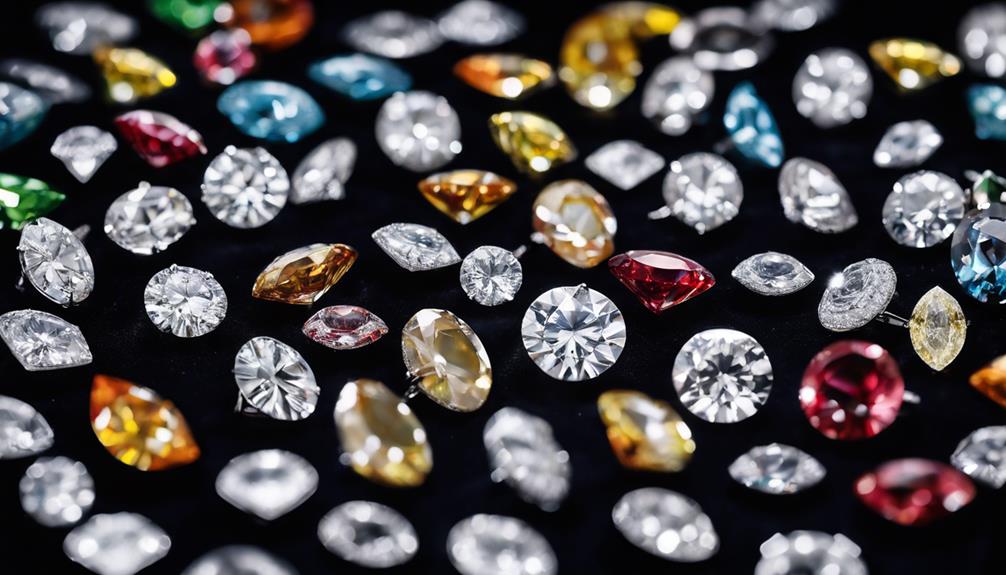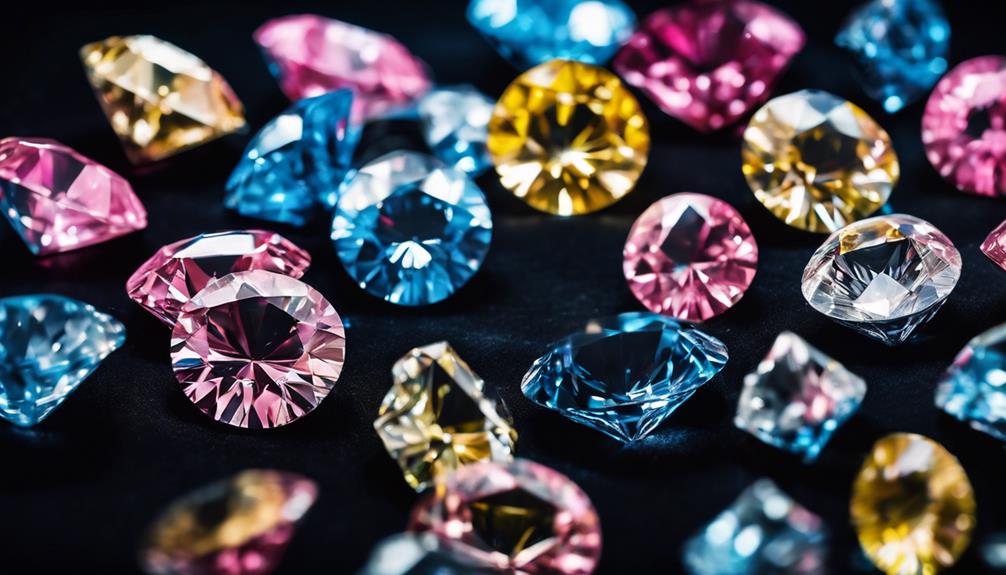When you’re choosing a diamond, understanding the color scale is key. This scale ranges from D (colorless) to Z (noticeable yellow/brown tints). D-F grades are virtually colorless and very rare, while G-J are near-colorless, offering great value without visible tints. K-M show faint color, and N-Z have obvious color. The diamond’s shape and setting can influence how its color is perceived. For example, white gold or platinum settings emphasize colorlessness, while yellow gold can mask warmer hues. Considering all these factors helps you make a smart purchase. To master the art of selecting the perfect diamond, explore deeper.
Understanding Diamond Color Grades

Grasping the nuances of diamond color grades is essential for making an informed purchase. The diamond color scale spans from D (completely colorless) to Z (visible yellowish or brownish tint). Professionals should conduct grading to guarantee accuracy and reliability. Typically, the difference between adjacent color grades, like G and H, is subtle and often imperceptible to the naked eye.
Color grades break down into several categories. D to F diamonds are colorless, with D being the rarest and most expensive. E and F grades are nearly indistinguishable from D under normal lighting. G to J grades are near colorless. G diamonds appear colorless, while H to J show increasing yellow tints under magnification or bright light. K to M grades exhibit faint color, with visible yellow tints starting from K. N to Z grades have noticeable yellow or brown tints and are generally not recommended for purchase.
The diamond’s shape and setting can influence the perceived color, so consider these factors when evaluating color grades. Understanding these distinctions will help you choose a diamond that aligns with your aesthetic preferences and budget.
Practical Buying Considerations
When buying a diamond, how do you guarantee you’re getting the best value for your money? Focus on diamonds that appear colorless to the naked eye, typically in the G-J range. These grades can save you up to 30% compared to D-color diamonds, while still providing a beautiful appearance.
Consider the setting and shape, which greatly influence color perception. For white gold or platinum settings, opt for H-J grades for round diamonds and G-I grades for princess, emerald, or asscher cuts. In yellow gold settings, K-M grades work well for round diamonds, while J-K grades are suitable for princess, emerald, or asscher cuts.
Pave or halo settings often enhance the diamond’s look, so G-I grades are recommended for these styles.
Don’t overlook diamonds with medium or strong blue fluorescence. These can appear whiter and cost less, offering excellent value.
Impact of Settings and Shapes

Understanding how settings and shapes influence a diamond’s perceived color can help you make a more informed purchase.
The setting you choose greatly impacts how the diamond’s color is perceived. For instance, white gold and platinum settings can enhance the colorless appearance of diamonds, making them seem whiter. On the other hand, yellow gold settings can complement and even mask the warmer hues of diamonds in the K-M color range.
The shape of the diamond also plays a vital role. Round brilliant cuts are excellent at concealing color, so you might opt for a slightly lower color grade without sacrificing visual appeal. Shapes like princess, emerald, and asscher cuts reveal color more readily, so selecting a higher color grade for these shapes is often advisable.
For pave, side-stone, or halo settings, diamonds in the G-I color range are typically recommended. These settings can make the center stone appear more vibrant and enhance its overall brilliance.
Importance of the Diamond Color Scale
The diamond color scale is vital because it directly affects the perceived quality and value of a diamond. When you’re selecting a diamond, understanding its color grade helps you make informed decisions about its aesthetic and financial worth.
The scale ranges from D (colorless) to Z (yellowish tint). A diamond with a higher color grade, closer to D, will appear clearer and more brilliant, often commanding a higher price.
However, minor differences between adjacent color grades, such as G and H, are usually imperceptible to the naked eye. This means you can often save money by choosing a slightly lower grade without sacrificing visible quality. For example, G-J grades are considered near colorless and can look just as stunning when set in jewelry, especially in white gold or platinum.
Grading should always be done by professionals to guarantee accuracy. The Gemological Institute of America (GIA) is a trusted authority in this field, providing reliable certification.
Balancing the color grade with other factors like size, clarity, and cut is essential. Remember, once a diamond appears clear, higher color grades offer minimal visual benefit but can greatly impact cost. Prioritize overall value over the color grade alone.
Colorless and Near Colorless Diamonds

As you consider the diamond color scale‘s impact on value, you’ll find that colorless (D-F) and near colorless (G-J) diamonds offer an excellent balance between appearance and cost.
Colorless diamonds, graded D to F, are the epitome of luxury. They’re incredibly rare, with no detectable color even under magnification, which makes them the most expensive. However, unless you’re a gemologist, you likely won’t notice the difference between these grades and the near colorless ones.
Near colorless diamonds, graded G to J, provide exceptional value. G-grade diamonds still appear colorless to the naked eye, while H diamonds show slight color only under magnification. As you move to I and J grades, you might notice a faint yellow tint, especially in bright light or larger stones. Despite this, these diamonds are considerably more affordable and still look stunning in most settings.
When choosing between these options, consider the diamond’s shape and setting. White gold and platinum settings enhance the colorless appearance, while yellow gold can complement the warmer tones of near colorless diamonds. This thoughtful approach guarantees you maximize both beauty and value in your diamond purchase.
Conclusion
When buying a diamond, remember that its color grade greatly affects both appearance and value. Aim for diamonds in the G-J range, as they offer great value and appear colorless to the naked eye.
Consider how different settings and shapes influence perceived color. White gold and platinum settings enhance colorless diamonds, while yellow gold complements warmer hues.
By understanding the GIA color scale and considering all factors, you’ll make an informed and satisfying purchase.



